La Stazione
La Stazione | |
|---|---|
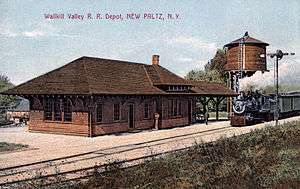 The station, depicted after its 1907 reconstruction | |
| Location | 5 Main Street, New Paltz, New York 12561[1] |
| Coordinates | 41°44′49″N 74°05′20″W / 41.746837°N 74.088954°WCoordinates: 41°44′49″N 74°05′20″W / 41.746837°N 74.088954°W |
| Owned by | Richard Ronkese |
| Construction | |
| Parking | 18 spots[2] |
| History | |
| Opened | December 20, 1870 |
| Closed | December 1958 |
| Rebuilt | 1988 |
La Stazione (Italian pronunciation: [la statˈtsjone], "The Station") is an Italian restaurant and former train station[note 1] in the village of New Paltz in Ulster County, New York. The building was the first of two railroad stations constructed in the town of New Paltz, and it is the only former Wallkill Valley Railroad station standing at its original location.
After a lengthy public debate over whether to place the station to the east or west of the Wallkill River, it was built in 1870 on the east bank, within the village of New Paltz. The rail line was formally opened during a large ceremony on December 20, 1870. A decade later the station had become a popular departure point for the Mohonk Mountain House by many vacationers, including two U.S. presidents. In the late 19th century, over a dozen stagecoaches ran between the station and Mohonk daily.
The station burned down in 1907 and was rebuilt later that year. The rise of the automobile caused the railroad to end passenger service in 1937; by 1959 the station was completely closed and sold off. After closure, it was used for a variety of businesses, including serving as a public-access television station. Freight service along the Wallkill Valley line continued until 1977, when the corridor was shut to regular rail traffic.
The building was in such a state of disrepair by the 1980s that it was almost demolished, and the nearby tracks were torn up and sold for scrap by 1984. However, the station avoided demolition and was renovated in 1988. It was used as a real estate office, and the rail corridor itself was formally opened five years later as the Wallkill Valley Rail Trail. In 1999, the station became an Italian restaurant and received its current name, La Stazione. The building was expanded in 2003 and served as the setting for a scene in a 2008 mob film.
Planning and construction
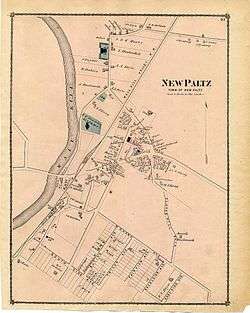
In February 1864, plans were in place to extend the route of the proposed Wallkill Valley Railroad between the towns of Shawangunk and New Paltz.[4] A civil engineering survey to determine a possible route and cost of such an endeavor was undertaken in March of that year.[5] The proposal sparked a controversy as to whether the route would run east or west of the Wallkill River in New Paltz. The western route was roughly 100 feet (30 m) shorter, and the eastern route would cost $25,000 more. However, it was felt that the increased economic activity from having the rail line run east of the river, and directly through the village of New Paltz, would offset the expense.[6][7] Bonding for the rail line through New Paltz, at a cost of $123,000, was completed by January 1869.[8][9] The Wallkill Valley Railroad was the first rail line in Ulster County, and was heralded as a cure for the region's isolation from the rest of the industrialized world.[10]
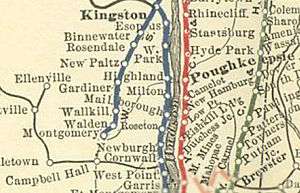
By November 1869, the Gardiner rail depot, to the south of New Paltz, was ceremoniously opened by the railroad's president, Floyd McKinstry. The station immediately began to see regular traffic.[10][11][12] A second Gardiner station was constructed in the hamlet of Forest Glen, in the northern part of Gardiner.[13] The railroad company was contractually obligated to start construction in New Paltz by May 18, 1870,[14] and work on the New Paltz station commenced that day. The depot was designed to be 20 by 80 feet (6.1 by 24.4 m).[15] The design included freight and baggage rooms, as well as a water tank and engine house. The station had two waiting rooms, while most stations on the Wallkill line only had one. The New Paltz station, as with the other Wallkill Valley stations, was based on "standard patterns ... rather than [being designed] by individual architects".[16]
Half the station's lumber came from Honesdale, Pennsylvania, via the Delaware and Hudson Canal[17] and its framework was raised on July 1, 1870.[18] Work was completed by September 1870. John C. Deyo had provided the carpentry, Snyder and Fuller painted it, and John C. Shaffer was the contractor.[19] Shaffer had also constructed living quarters for the railroad's workers.[20]
The masonry for a bridge over the Plattekill Creek between Gardiner and New Paltz was completed by late June 1870,[21] and trestle work was done by July.[22] Beginning in late September 1870, the railroad had begun laying tracks between Gardiner and New Paltz.[23] The tracks reached the Plattekill Creek bridge by the end of October,[24] and the rail line reached New Paltz on December 1, 1870.[25]
Opening and early operation
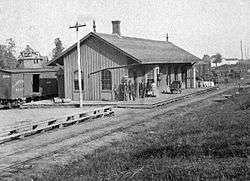
The rail line was officially opened in New Paltz on December 20, 1870, during a day-long celebration. At that time, the Wallkill Valley line was connected to the Erie Railroad's Montgomery–Goshen branch to the south; an inaugural train containing about 350 passengers ran to Goshen, making stops at each station along the way, before heading back to New Paltz.[10] The station's telegraph was used to "receive ... election returns" throughout the 1870s.[26]
On March 3, 1880, four men robbed the station's safe. They broke into the depot late at night and dragged the safe to the center of the station. They then attempted to drill holes into the safe and explode it with gunpowder, but failing that, cut off one of its sides. The contents of the safe were 300 cigars and a few bills and papers. After the suspects were arrested in Poughkeepsie, the local sheriff was reluctant to transfer the suspects to New Paltz.[27] The Poughkeepsie police were insistent that they be paid immediately for their services.[28] The day after their arrest, the men were allowed to go to a barber shop for a shave; some witnesses were unable to identify the suspects because of this, and the officers were publicly chided for incompetence. Cigars in the suspects' pockets were identical to the cigars in the safe, and along with tools recovered from the site, they were used to identify the men. The suspects were brought to a jail in Kingston pending the ruling of a grand jury that April. A large crowd gathered at the New Paltz depot to watch them depart. The men were described as "cracksmen of the first water", possibly "stylish",[note 2] and so proficient at safe-cracking that, "if they [had] any chance at all, or [got] hold of any weapon, they [would] pick their way thro' the jail as easily as boring through a lime heap".[27] The men were subsequently convicted.[29] As a result of the burglary, station agent Dwight Marsh was given a revolver,[26] and it became policy not to keep valuables in the safe overnight. On December 8, 1880, another thief broke a window at the depot and stole a box of cigars.[29]
Two sheds had been built adjacent to the station by 1881.[30] The land the sheds were built on was purchased the previous year by Mohonk Mountain House co-founder Albert Smiley for $500.[31][32] The sheds were built for the resort's horses.[33] During this period, as many as 14 stagecoaches each day transported guests between the station and Mohonk.[8] The West Shore Railroad purchased the Wallkill Valley line in June 1881,[34] and placed an additional siding by the depot in 1887 to allow daily "special extra-fare trains ... for the Minnewaska and Mohonk visitors".[35]
President Chester A. Arthur visited the station with his daughter in 1884. He was welcomed by the railroad's director and brought to Lake Mohonk.[36] President Rutherford B. Hayes occasionally attended conferences at the Mohonk Mountain House. In 1892, several townspeople held a reception for him at the station, giving him "three rousing cheers". Other notable Mountain House guests who arrived by train were opera singer Ernestine Schumann-Heink and orator William Jennings Bryan.[35] A sewage line was installed from the station to the Wallkill River in 1905.[37]
Springtown station
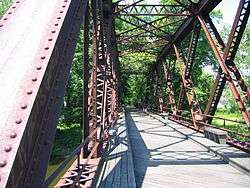
As soon as the station in the village was completed, a second station was built at Springtown,[38] a hamlet in the northwestern part of the town of New Paltz[39] that once sported "its own post office, church, school, hotel, a gambling den ... and a bevy of bars".[40] The station was planned to be two stories tall with an area of 16 by 40 feet (4.9 by 12.2 m).[41] A 413-foot (126 m) bridge[42] across the Wallkill River to Springtown was completed by December 1870,[43] and the station was constructed at the point where the rail line crossed Coffey Road.[44] Throughout its history, the Springtown station was occupied by various tenants who took up residence.[45]
The original New Paltz station burned down around 4:45 A.M. on April 23, 1907, damaging freight and killing station agent E. J. Snyder's dog. The fire originated in the office stove, and spread rapidly before local fire companies could arrive.[46] A passenger car was used as a temporary station while the building was rebuilt.[47] By late September 1907, the concrete foundation and the framework of the new building had been put in place,[48] but work on the interior did not begin until November because the lumber had not arrived.[49] The depot was completely rebuilt by December 31, 1907,[50] and in active use by February 7, 1908.[51] While the original station had a gabled roof, the rebuilt station was hipped. The direction of the new station's battens was horizontal; the original station had had vertical slats.[20] The rebuilt freight house was placed a distance from the depot.[52]
The building was not fully rebuilt until 1911.[38] A house was constructed at the site of the Springtown depot the year before it was rebuilt.[53] The New York Public Service Commission, a regulatory agency founded in 1907,[54] ruled in May 1911 that the new Springtown station was adequate.[55] The Springtown station had no station agent or freight house.[38] In 1925, sparks shooting off a passing train caused a fire in Springtown that burned down six buildings, causing $7,000 in damage.[56] The prominence of the New Paltz station, as well as the growth of SUNY New Paltz in the village, caused the decline of Springtown as a community.[40]
Closure
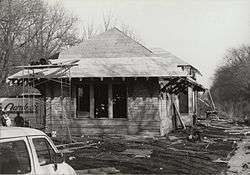
Passenger service along the Wallkill Valley line ceased in 1937,[57] due to the increased usage of automobiles.[58] By December 1958 the building (then owned by the New York Central Railroad) was no longer used as a railroad station.[59][60] It was sold off in 1959,[61] and hosted a number of local endeavors, serving as a chapter house for the Knights of Columbus and as an office for a public-access television station.[62] Under the ownership of the television station, the roof and floorboards were repaired.[63]
In April 1977, the owner of the property, Fetner and Gold Associates, attempted to open the building as a bar. Their zoning permit was rejected; the village mayor was "unalterably opposed" to the prospect, and the board believed the proposed bar would lead to complaints from nearby apartments. It was also believed that it would be unsafe to open a bar adjacent to an active rail line, and that such a venture would threaten the nearby Huguenot Street Historic District.[61][62] On December 31, 1977, all regular freight service ceased along the Wallkill Valley line.[64] By the early 1980s the depot had become a "hangout for youths to drink and carouse" and the village considered dismantling it.[65] Conrail, at that time the owner of the rail line, removed all tracks along the corridor between 1983 and 1984 and salvaged the steel.[66]
Renovation
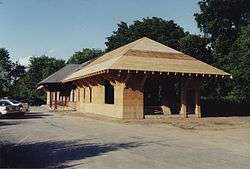
Robert Mark Realty bought the former station in 1986[8] and renovated it at a cost of $175,000.[60] Work began in October 1987 and was more than halfway done by January 1988. Matt Bialecki, the architect who had overseen the renovation of the former New Paltz opera house as a restaurant, served as the project's architect. Wilro Builders served as the contractor.[67] The building's design follows a Shingle Style architecture and its sidings are both shingle and clapboard. There are bay windows on the east and west faces, and rafters are partly visible.[68] The building served as a real estate office.[67]
On February 9, 1999, the village approved a plan to allow the building to open as a 36-seat Italian restaurant under the co-ownership of two men, Jeff DiMarco and Rocco Panetta. It was at this time the station was given its current name, La Stazione.[2][8][69] DiMarco had previously managed construction for an adjacent restaurant, the Gilded Otter. He sold his ownership of La Stazione in August 2000.[70]
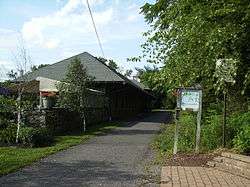
The building is adjacent to a rail trail,[71] and there is a 3-foot (0.91 m) bike rack by the building's northern end.[72] The village of New Paltz purchased its section of the former Wallkill Valley rail corridor from Conrail in 1991, formally opening it on October 9, 1993 as a public walkway, the Wallkill Valley Rail Trail.[73] The permit allowing La Stazione to operate as a restaurant also required the placement of a sign in the building's parking lot to indicate the presence of the trail.[69] The village allowed La Stazione to place a public picnic table under an overhang by the rail trail, on the condition that the restaurant did not provide outdoor food service. In August 1999, the restaurant was forced to remove a gas tank and gas line that were placed under the trail; failure to do so could have resulted in the revocation of La Stazione's certificate of occupancy, preventing the building from being operated as a restaurant.[74][75]
In 2001, the village was experiencing water drainage issues in the area by the restaurant.[76] By early 2002, the village approved plans for an expansion of La Stazione, which addressed the drainage issues; the restaurant offered to install larger pipes than were necessary in exchange for the village "defray[ing] their costs".[77][78] When the Gardiner station burned down on October 10, 2002, La Stazione was left as the last former station of the Wallkill Valley Railroad remaining at its original location.[16][79] The building's addition was completed in 2003.[68]
A scene from the 2008 mob film Front Man was filmed at La Stazione; the film's director, Ray Genadry, is the cousin of the restaurant's owner, Rocco Panetta. The scene featured Chris Colombo, son of the late Joseph Colombo, a former boss of the Colombo crime family.[80][81] Colombo had previously starred in a 2005 mobster documentary on HBO.[82][83] The building was added to the New Paltz Downtown Historic District on July 24, 2009.[68][84]
Former Wallkill Valley stations
- Binnewater Historic District
- Campbell Hall (Metro-North station)
- Kingston, New York railroad stations
References
Explanatory notes
Citations
- ↑ "La Stazione". Metromix. Chicago, IL: Gannett Company. Archived from the original on July 21, 2011. Retrieved 2010-11-09.
- 1 2 Suzuki, Chiho (1999-02-11). "Rail station to become restaurant". Daily Freeman. Kingston, NY: Journal Register Company.
- ↑ Wiatrowski 2007, p. 152.
- ↑ "Railroad Meeting". New Paltz Times. New Paltz, NY: C.J. Ackert. 1864-02-14.
- ↑ Miller, Sidney G. (1864-03-25). "Wallkill Valley Railroad from Shawangunk to New Paltz Report and Estimate". New Paltz Times. New Paltz, NY: C.J. Ackert.
- ↑ "Rail-Road Meetings". New Paltz Times. New Paltz, NY: C.J. Ackert. 1868-02-13.
- ↑ "Wallkill Valley Rail Road". New Paltz Times. New Paltz, NY: C.J. Ackert. 1868-12-03.
- 1 2 3 4 "Pasta junction – on the right track in New Paltz". Times Herald-Record. Middletown, NY: Dow Jones Local Media Group. 1999-07-02. p. 24.
- ↑ D.C. McMillan (1869-01-07). "Wallkill Valley Railroad Meeting". New Paltz Independent. New Paltz, NY.
- 1 2 3 Mabee 1995, pp. 12–14.
- ↑ New Paltz Independent. New Paltz, NY. 1869-11-11. Missing or empty
|title=(help) - ↑ New Paltz Independent. New Paltz, NY. 1869-11-18. Missing or empty
|title=(help) - ↑ Sylvester 1880, p. 290.
- ↑ "Railroad Progress". New Paltz Independent. New Paltz, NY. 1869-08-19.
- ↑ New Paltz Independent. New Paltz, NY. 1869-05-25. Missing or empty
|title=(help) - 1 2 Mabee 1995, p. 47.
- ↑ New Paltz Independent. New Paltz, NY. 1870-05-09. Missing or empty
|title=(help) - ↑ New Paltz Independent. New Paltz, NY. 1870-07-07. Missing or empty
|title=(help) - ↑ New Paltz Times. New Paltz, NY: C.J. Ackert. 1870-09-01. Missing or empty
|title=(help) - 1 2 Mabee 1995, p. 49.
- ↑ New Paltz Times. New Paltz, NY: C.J. Ackert. 1870-06-30. Missing or empty
|title=(help) - ↑ New Paltz Independent. New Paltz, NY. 1870-07-14. Missing or empty
|title=(help) - ↑ "Railroad Items". New Paltz Independent. New Paltz, NY. 1870-09-22.
- ↑ "Railroad Items". New Paltz Independent. New Paltz, NY. 1870-10-27.
- ↑ "Rail Line Completed to New Paltz". New Paltz Times. New Paltz, NY: C.J. Ackert. 1870-12-01.
- 1 2 Mabee 1995, p. 45.
- 1 2 3 "The Testimony In The Safe Burglary Case". New Paltz Independent. New Paltz, NY. 1880-03-11. p. 2.
- ↑ New Paltz Independent. New Paltz, NY. 1880-03-18. Missing or empty
|title=(help) - 1 2 New Paltz Independent. New Paltz, NY. 1880-12-16. p. 2. Missing or empty
|title=(help) - ↑ New Paltz Independent. New Paltz, NY. 1881-06-23. Missing or empty
|title=(help) - ↑ New Paltz Independent. New Paltz, NY. 1880-12-16. Missing or empty
|title=(help) - ↑ "Alfred H. Smiley and Albert K. Smiley". Redlands Historical Society. Archived from the original on July 13, 2011. Retrieved 2010-12-22.
- ↑ Mabee 1995, p. 84.
- ↑ Mabee 1995, p. 39.
- 1 2 Mabee 1995, p. 85.
- ↑ Mabee 1995, pp. 84–85.
- ↑ New Paltz Independent. New Paltz, NY. 1905-07-28. Missing or empty
|title=(help) - 1 2 3 Mabee 1995, pp. 52, 155.
- ↑ Sylvester 1880, p. 13.
- 1 2 Townshend, Mike (2010-11-11). "Springtown, N.Y. Historic Huguenot's Heyl de Ortiz lectures on forgotten town". New Paltz Times. Kingston, NY: Ulster Publishing. Retrieved 2011-01-31.
- ↑ New Paltz Times. New Paltz, NY: C.J. Ackert. 1870-01-05. Missing or empty
|title=(help) - ↑ Chazin 2001, pp. 289–290.
- ↑ New Paltz Independent. New Paltz, NY. 1870-12-15. Missing or empty
|title=(help) - ↑ Mabee 1995, p. 155.
- ↑ New Paltz Independent. New Paltz, NY. 1881-06-03. Missing or empty
|title=(help) - ↑ "Fire Damages New Paltz Station". Daily Freeman. Kingston, NY. 1907-04-23. p. 3. Retrieved 2010-12-08.
- ↑ "Station in a Car". Daily Freeman. Kingston, NY. 1907-05-03. p. 1. Retrieved 2010-12-08.
- ↑ New Paltz Independent. New Paltz, NY. 1907-09-27. Missing or empty
|title=(help) - ↑ New Paltz Independent. New Paltz, NY. 1907-11-08. Missing or empty
|title=(help) - ↑ New Paltz Independent. New Paltz, NY. 1907-12-31. Missing or empty
|title=(help) - ↑ New Paltz Independent. New Paltz, NY. 1908-02-07. Missing or empty
|title=(help) - ↑ New Paltz Independent. New Paltz, NY. 1907-08-30. Missing or empty
|title=(help) - ↑ New Paltz Independent. New Paltz, NY. 1910-11-18. Missing or empty
|title=(help) - ↑ Reports of the Board of Public Utility Commissioners of the State of New Jersey. 4. Union Hill, NJ: Hudson Printing Company. 1917. p. 240. Retrieved 2011-02-05.
- ↑ "Springtown Satisfied". Daily Freeman. Kingston, NY. 1911-05-26. Retrieved 2011-01-23.
- ↑ "Fire Destroys Six Buildings At Springtown". New Paltz Independent and Times. New Paltz, NY. 1925-06-18.
- ↑ New Paltz Independent and Times. New Paltz, NY. 1937-08-12. Missing or empty
|title=(help) - ↑ Mabee 1995, p. 133.
- ↑ "New York Central to Close Stations at New Paltz, Wallkill, Walden, Rosendale, Gardiner". New Paltz Independent and Times. New Paltz, NY. 1958-12-17.
- 1 2 "Back on Track". Times Herald-Record. Middletown, NY: Dow Jones Local Media Group. 1988-03-09.
- 1 2 "'No Bar in R.R. Station', Zoning Bd. Of Appeals". New Paltz News. New Paltz, NY. 1977-04-13.
- 1 2 "Railroad Station Bar Denied by Zoning Board". Huguenot Herald. New Paltz, NY. 1977-04-13.
- ↑ Thomas, Lauren (1999-01-14). "Old New Paltz railroad station may become Italian restaurant". Huguenot Herald. New Paltz, NY.
- ↑ Mabee 1995, p. 135.
- ↑ Muise, Jeff (1984-01-25). Times Herald-Record. Middletown, NY: Dow Jones Local Media Group. p. 30. Missing or empty
|title=(help) - ↑ Mabee 1995, p. 139.
- 1 2 "New Paltz rail station to become real estate office". Huguenot Herald. 1988-01-07.
- 1 2 3 Larson, Neil (March 2009). "National Register of Historic Places Registration: New Paltz Downtown Historic District" (Java). New York State Office of Parks, Recreation and Historic Preservation. p. 4 of 31 (document p. 24). Retrieved 2011-03-04.
- 1 2 Fanelli, Diane (1999-02-17). "A new restaurant for the New Paltz Gateway". New Paltz News. New Paltz, NY.
- ↑ "Custom home building". Huguenot Herald. New Paltz, NY. 2000-08-17.
- ↑ Perls 2003, p. 342.
- ↑ "Final Phrase B Report of the New Paltz Transportation-Land Use Project" (PDF). Village of New Paltz. 2006-06-20. p. 52. Archived from the original (PDF) on 2011-07-18. Retrieved 2011-02-07.
- ↑ Mabee 1995, pp. 141–144.
- ↑ Fanelli, Diane (1999-08-18). "La Stazione required to meet site plans". New Paltz News. New Paltz, NY.
- ↑ Quinn, Erin (1999-08-19). "Dispute concerning La Stazione's encroachment on the rail trail settled". Huguenot Herald. New Paltz, NY.
- ↑ "Village Board or Trustees Meeting Minutes for December 12, 2001". Village of New Paltz. 2002-01-16. p. 4. Archived from the original (PDF) on 2011-02-09. Retrieved 2011-02-07.
- ↑ "Village Board or Trustees Meeting Minutes for January 23, 2002". Village of New Paltz. 2002-04-10. p. 3. Archived from the original (PDF) on 2011-02-09. Retrieved 2011-02-07.
- ↑ "Village Board or Trustees Meeting Minutes for September 25, 2002". Village of New Paltz. 2002-10-30. p. 5. Archived from the original (PDF) on 2011-02-09. Retrieved 2011-02-07.
- ↑ Mabee 2003, p. 22.
- ↑ Mackson, Oliver (2007-08-18). "New Paltz restaurant a hit in 'Mob" movie". Times Herald-Record. Middletown, NY: Dow Jones Local Media Group. Retrieved 2010-12-14.
- ↑ "Front Man (2008)". IMDB. Retrieved 2010-12-14.
- ↑ Mackson, Oliver (2007-04-01). "After a trial fails to find him guilty of racketeering, Chris Colombo explores a few new possibilities". Times Herald-Record. Middletown, NY: Dow Jones Local Media Group. Retrieved 2010-12-14.
- ↑ "House Arrest Starring Chris Colombo (TV 2005)". IMDB. Retrieved 2010-12-14.
- ↑ "National Register of Historic Places Listings". National Register of Historic Places. 2009-07-31. Retrieved 2011-03-04.
Bibliography
- Chazin, Daniel D. (2001). New York Walk Book: A Companion to the New Jersey Walk Book (7th ed.). Mahwah, NJ: New York – New Jersey Trail Conference. ISBN 1-880775-30-1.
- Mabee, Carleton (2003). Gardiner and Lake Minnewaska. Mount Pleasant, SC: Arcadia Publishing. ISBN 0-7385-1185-4.
- Mabee, Carleton (1995). Listen to the Whistle: An Anecdotal History of the Wallkill Valley Railroad. Fleishmanns, NY: Purple Mountain Press. ISBN 0-935796-69-X.
- Perls, Jeffrey (2003). Shawangunks Trail Companion: A Complete Guide to Hiking, Mountain Biking, Cross-Country Skiing, and More Only 90 Miles from New York City. Woodstock, VT: Countryman Press. ISBN 0-88150-563-3.
- Sylvester, Nathaniel Bartlett (1880). History of Ulster County, New York, with Illustrations and Biographical Sketches of its Prominent Men and Pioneers: Part Second: History of the Towns of Ulster County. Philadelphia, PA: Everts & Peck. OCLC 2385957.
- Wiatrowski, Claude A. (2007). Railroads Across North America: An Illustrated History. St. Paul, MN: Voyageur Press. ISBN 978-0-7603-2976-4.
External links
| Wikimedia Commons has media related to La Stazione. |
- La Stazione - Home
- Olsen, Thomas G. (2006-04-20). "Landmark Designation Form" (PDF). Village of New Paltz Historic Preservation Commission. Retrieved 2013-02-09.